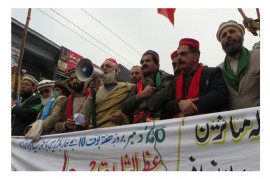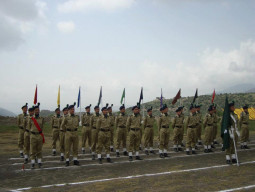
PESHAWAR: The latest survey conducted by the FATA Secretariat and the Bureau of Statistics shows that war and extremism has left the tribal belt in tatters. Only 4,000 houses were surveyed in all of the Federally Administered Tribal Areas (Fata) except North Waziristan, and parts of Khyber and Orakzai agencies and information extracted during this exercise revealed some alarming figures. Statisticians consulted by The Express Tribune, however, say results of a survey of 4,070 households cannot be successfully generalised in a region with a population of 3,656,452 (figure from FATA Development Authority).
State of education
At least 44.2% children in Fata have never enrolled in school despite the fact that the average distance from an institute is 1.8 kilometres as opposed to 3.4km in Khyber-Pakhtunkhwa. The volatile security situation is to blame as the availability of schools and quality of education is adversely affected.
360 FATA schools were destroyed in 2015
This and several other facts were revealed by the FATA Secretariat in the first statistical review since 2009 when terrorism reigned supreme in the tribal belt. These numbers were revealed by the FATA Secretariat in a report called the FATA Development Indicators Household Survey (FDIHS) 2013-14. It looked at over 50 indicators and concluded, rather unsurprisingly, “Fata still fares worse than the rest of Pakistan.”
The report explains North Waziristan and parts of Khyber and Orakzai agencies have not been surveyed due to security threats. Without these three agencies, the population of Fata stands at 2,298,476.
Education
As far as education is concerned, the overall literacy rate in Fata is 33.3%; far less than the national average of 58%, as estimated in 2013-14. Similarly, the adult literacy rate in Fata is 28.4% while the national average is 57%. There is a marked gender gap in literacy. Male adult literacy rate in Fata is 45% whereas the same for women is a mere 7.8%.
Six cadet colleges to be established in FATA
The Gross Enrolment Rate (GER) at the primary level (six-10 years of age) is 77.4% for Fata while the rest of the country stands at 91%. Only a small proportion (2.3%) of currently enrolled children aged between six and 15 attend religious schools, while 68.6% go to government schools and 29.1% are in private schools. Khyber Agency has the highest literate population above the age of 10 at 49.4% and Bajaur Agency has the lowest at just 19.6%.
In bad health
The health sector in Fata paints an equally disastrous picture as the proportion of births attended by skilled health personnel is just 29.5%; far below 86% – recorded at the national level. The maternal mortality ratio (MMR) for Fata is 395 per 100,000 compared to 275 for K-P.
The share of completely immunised children under 12-23 months in Fata is 33.9% while
the figure for the rest of the country is 86%.
Army chief inaugurates Wana Cadet College in FATA
As part of the survey, 59.6% of households thought the quality of health care remained unchanged, while 30.8% thought it worse than before.
Looking for work
Turning to employment, the crude activity rate for Fata is 24.2% and 32.3% for the rest of Pakistan. At the same time, refined activity rate stands at 35.2% compared to the national average of 45.5%. A gender gap exists here as well as only 5.9% women are part of the labour force. Unemployment rates of people between ages 15 and 64 is higher in Fata at 7.1% compared to the national rate of 5.6%.
The construction sector accounts for the largest share (36.2%) of workers in Fata as a whole. Unemployment among the tribal youth is particularly high at 11.8% compared to 10.3% for the remainder of the country. Alarmingly, this age bracket is also the main resource pool for militant recruitment and can be easily influenced by propaganda.
Family members working abroad or outside the tribal areas are an important source of economic sustenance. At least 7.5% of households in Fata have workers abroad. This figure is higher than K-P (1.38%), Sindh (2.28%) and Balochistan (0.06%), but similar to Punjab (7.4%), says the report.
The data related to children in the work force was equally disturbing. In the tribal belt, an overall 6.9% of the children between five and 14 years of age are involved in child labour.
Published in The Express Tribune, December 29th, 2015.





































1713525343-0/WhatsApp-Image-2024-04-19-at-4-09-16-PM-(1)1713525343-0-270x192.webp)
1713525453-0/Henry-Cavill-in-James-Bond-(AI)1713525453-0-270x192.webp)


















COMMENTS
Comments are moderated and generally will be posted if they are on-topic and not abusive.
For more information, please see our Comments FAQ